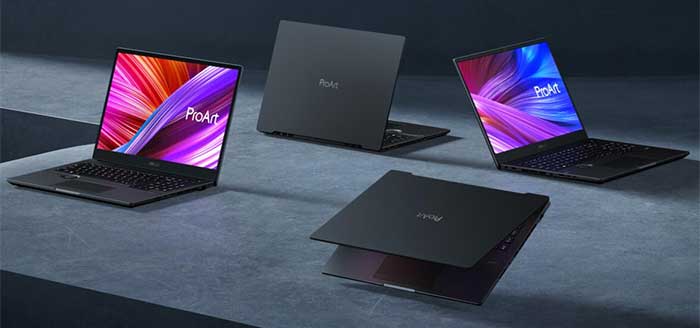Asus launched a lot of attractive new PCs and devices on Thursday. Most of the gear was targeting the content creator market, under the ProArt sub-brand, but there were also some new Zenbooks, business and gaming monitors, plus a pocket projector with auto portrait mode. You can read about all the new Asus products via its EdgeUp blog, but today I wanted to highlight the new Asus ProArt Studiobook 16 which integrates a dial into the palm rest, think of it like an embedded Surface Dial.

Asus is providing a range of pre-built specs for customer interested in the ProArt Studiobook 16. If you head on over to the product pages, you will find at least eight models (regular and Pro) to compare. In terms of specs you will have some big choices to make; whether to go for a Pantone Validated and Calman Verified IPS or OLED screen, AMD Ryzen or Intel Core/Xeon (Pro) processor, and Nvidia RTX A-series (Pro) or GeForce RTX 3000 graphics. Remember that if you want Thunderbolt 4 USB-C, you will have to go for an Intel platform, but both AMD and Intel models have lots of modern ports like USB 3.2 Gen 2 Type-C ports, HDMI 2.1, and a superfast SD Express 7.0 card reader. You can also spec up to 64GB of dual channel DDR4 3200 RAM and fill the two M.2 PCIe SSD slots for up to 8TB of built-in storage. Suffice to say, the specs are pretty top-notch, as long as you have the budget.
As per our headline, one of the biggest draws of the new ProArt Studiobook 16 / Pro 16 OLED might be its Surface Dial-like hardware, the 'Asus Dial', built into the keyboard deck. You can see it in some still images here in this article, but it is best seen in action in videos, like the official one above, and YouTuber Dave Lee's enthusiastic reaction to this technology becoming available built-into a laptop.
"Turn the ASUS Dial clockwise or counterclockwise, and a circular on-screen menu will pop up. Select the function you need and press in on the dial, and you’ll be able to spin it to adjust the related value precisely," explains Asus. "It's a quick and easy mechanism for changing tools or parameters without losing focus on the task at hand, and it’s ready to streamline your workflow in Adobe After Effects, Photoshop, Premiere Pro, and Lightroom Classic." Buyers of this laptop get three free months of Adobe Creative Cloud access (new and existing customers).

In addition to this Dial control, Asus has implemented an oversized touchpad with stylus support and up to 1024 levels of pressure sensitivity. Below this input area, you will see three 'mouse buttons', as the middle button is often used in 3D design and CAD applications.
The Asus ProArt Studiobook 16 OLED will be released in Q4 this year starting from $1999, with the Pro OLED model starting from $2499.

For those with slightly less deep pockets, Asus is looking to democratise its Dial technology, starting with the new Vivobook Pro 14X/16X line. The more affordable alternatives still come packing up to a 16-inch NanoEdge 4K OLED display, AMD Ryzen 9 5900HX Mobile Processor, and Nvidia GeForce RTX 3050 Ti graphics – but here the Asus exclusive 'DialPad' offers responsive dial-like functionality.
Again, the new Vivobook Pro models will be available from Q4 this year, this time starting at $1399.













